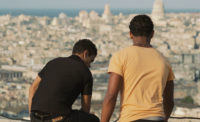In recent years, Pittsburgh has become the envy of the Rust Belt. After years of hard work, the city shed its grimy, “Hell with the lid off” image and recast itself as one of America’s most livable (and attractive) cities. Today it’s a midwestern tech hub, a center of higher education, and a national health care leader.
Drive 15 miles east of downtown and the story is grimmer. In the small town of Braddock, once a thriving community of laborers and immigrants manning some of the most important mills in the country, there’s no end in sight to the city’s post-industrial downward spiral. When big steel retreated overseas, it left shattered lives, splintered communities, and a fractured civic identity in its wake. Decades later, the Great Recession further crippled the town. By 2010, a city that boasted a population of more than 20,000 in 1920, had only 2,159 residents.
It’s this Braddock, an urban husk of abandoned homes, empty lots, and mountains of frustration, that New York and Paris-based directors Gabriella Kessler and Jean-Loïc Portron capture so poignantly in their challenging, essential documentary Braddock America, which was released on DVD and VOD on September 1. Shot in 2012, the film is a record of Braddock at perhaps its lowest point. Attempts to sell the city as a frontier for urban pioneers fell flat. Its hospital was razed by the same health system fueling the Pittsburgh recovery. Hope was hard to find; jobs even tougher.
Kessler and Portron’s cameras are flies on the wall at civic meetings, local hangouts, and rallies, capturing every struggle in heartbreaking detail. To really make you feel Braddock’s pain, the directors present the city’s golden age through black and white archival footage layered with a droning soundscape that gives the old film a haunting David Lynch-like quality. In the context of the city’s present, this look backwards (especially through home movies) is brutal.
Despite how bad things are, Kessler and Portron find a dedicated group of homeowners, hustlers, police, community leaders, business owners, historians, and artists determined to protect the city and its legacy so that it can one day rise again. A pipe dream? Maybe. But Braddock America celebrates the grit and determination of everyday people committed to finding some shard of hope in a city laid so low and reminding us that there’s so much worth protecting in these places we’d rather ignore.
“Why haven’t you left?” is a question that’s asked repeatedly throughout the film. Everyone has a different answer, but they invariably come back to the same thing: pride, in their neighbors, in their communities, and in themselves. These frustratingly, admirably stubborn residents believe they can achieve something great together, despite the forces working against them, because this is their home. Through its empathetic, heroic treatment of Braddock’s true believers, Braddock America achieves something unimaginable: It finds a shoot of optimism among the urban ruins.







Post a comment to this article
Report Abusive Comment